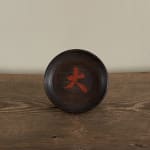



artisan's name unknown
Tōdaiji lacquer plate (set of 5), early 1900s
lacquered wood
5 1/4" X 1/2"
Further images
These lacquer plates were made from old wood that was removed from the Todai-ji during a repair of a small section of the temple. Around temples, particularly very important ones...
These lacquer plates were made from old wood that was removed from the Todai-ji during a repair of a small section of the temple. Around temples, particularly very important ones such as the Tōdaiji, there exists a network of craftsmen residing alongside the temple-complex. For these craftsmen, one of the highest honors they can receive is to be invited to collaborate in repairs of the temple with esteemed miya-daiku (temple – carpenters) or even be given the chance to use the recycled wood, under the temple’s supervision.
Japanese temples are repaired multiple times throughout their lives, ranging from large restorations to small repairs. The majority of these structures were built using wood; combined with the thousand-year old, highly-complex technique of kigumi 木組 (interlocking wooden joints) – a technique that does not require any nail, bolts, screws, nor glue – that has been passed on from our ancestral daiku. They foresaw the material’s vulnerability to rotting, breakage, and exposure to natural disasters, thereby developing a method to build structures that are designed to be disassembled; this way, parts of the temple could be restored without an entire overhaul of the massive structure. When repaired old wooden pieces are removed and replaced, they are often recycled as wooden plates, small buddha statues, other craft objects, or in some cases even furniture.
Temples have long been one of the centers of culture in Japan. It is no surprise that the construction and maintenance of these temples have thus been entrusted to the highest level of craftsman at that time in that region. Moreover, recycling materials from a temple was no exception; although these adjacent craftsmen may not have been regarded on the level of the sculptors of Buddha statues, their works always had to pass the critical and discerning eye of the temple. Small recycled pieces like these were gifted to important followers and donors to the temples.
On the surface of the wooden plates, a dark lacquer is thinly applied, leaving the feel of the old wood. Then in red lacquer the kanji character DAI 大 - of TōDAIji (Buddhist tsemple located in Nara) - is written in the middle on each plate. This set of 5 was discovered in its original wooden container. Its label suggests it was one a part of a prominent family’s art collection.
Japanese temples are repaired multiple times throughout their lives, ranging from large restorations to small repairs. The majority of these structures were built using wood; combined with the thousand-year old, highly-complex technique of kigumi 木組 (interlocking wooden joints) – a technique that does not require any nail, bolts, screws, nor glue – that has been passed on from our ancestral daiku. They foresaw the material’s vulnerability to rotting, breakage, and exposure to natural disasters, thereby developing a method to build structures that are designed to be disassembled; this way, parts of the temple could be restored without an entire overhaul of the massive structure. When repaired old wooden pieces are removed and replaced, they are often recycled as wooden plates, small buddha statues, other craft objects, or in some cases even furniture.
Temples have long been one of the centers of culture in Japan. It is no surprise that the construction and maintenance of these temples have thus been entrusted to the highest level of craftsman at that time in that region. Moreover, recycling materials from a temple was no exception; although these adjacent craftsmen may not have been regarded on the level of the sculptors of Buddha statues, their works always had to pass the critical and discerning eye of the temple. Small recycled pieces like these were gifted to important followers and donors to the temples.
On the surface of the wooden plates, a dark lacquer is thinly applied, leaving the feel of the old wood. Then in red lacquer the kanji character DAI 大 - of TōDAIji (Buddhist tsemple located in Nara) - is written in the middle on each plate. This set of 5 was discovered in its original wooden container. Its label suggests it was one a part of a prominent family’s art collection.
Signup for our Newsletter
You will receive two emails a month from us. One introduces artworks and design works from Kyoto's hidden sources and the other is stories from Misako, sharing insights into Japanese culture.
* denotes required fields
为了回应您的查询,我们将根据我们的隐私政策处理您提供的个人数据。



